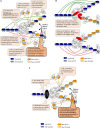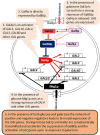Variation, Variegation and Heritable Gene Repression in S. cerevisiae
- PMID: 33747046
- PMCID: PMC7970126
- DOI: 10.3389/fgene.2021.630506
Variation, Variegation and Heritable Gene Repression in S. cerevisiae
Abstract
Phenotypic heterogeneity provides growth advantages for a population upon changes of the environment. In S. cerevisiae, such heterogeneity has been observed as "on/off" states in the expression of individual genes in individual cells. These variations can persist for a limited or extended number of mitotic divisions. Such traits are known to be mediated by heritable chromatin structures, by the mitotic transmission of transcription factors involved in gene regulatory circuits or by the cytoplasmic partition of prions or other unstructured proteins. The significance of such epigenetic diversity is obvious, however, we have limited insight into the mechanisms that generate it. In this review, we summarize the current knowledge of epigenetically maintained heterogeneity of gene expression and point out similarities and converging points between different mechanisms. We discuss how the sharing of limiting repression or activation factors can contribute to cell-to-cell variations in gene expression and to the coordination between short- and long- term epigenetic strategies. Finally, we discuss the implications of such variations and strategies in adaptation and aging.
Keywords: chromatin; diversity; gene regulatory circuits; gene repression; gene silencing; long non-coding RNA; phenotypic heterogeneity.
Copyright © 2021 Shaban, Sauty and Yankulov.
Conflict of interest statement
The authors declare that the research was conducted in the absence of any commercial or financial relationships that could be construed as a potential conflict of interest.
Figures





Similar articles
-
Regulated recruitment of HP1 to a euchromatic gene induces mitotically heritable, epigenetic gene silencing: a mammalian cell culture model of gene variegation.Genes Dev. 2003 Aug 1;17(15):1855-69. doi: 10.1101/gad.1102803. Epub 2003 Jul 17. Genes Dev. 2003. PMID: 12869583 Free PMC article.
-
Epigenetic gene silencing alters the mechanisms and rate of evolutionary adaptation.Nat Ecol Evol. 2019 Mar;3(3):491-498. doi: 10.1038/s41559-018-0781-2. Epub 2019 Feb 4. Nat Ecol Evol. 2019. PMID: 30718851
-
Environmental perception and epigenetic memory: mechanistic insight through FLC.Plant J. 2015 Jul;83(1):133-48. doi: 10.1111/tpj.12869. Epub 2015 May 29. Plant J. 2015. PMID: 25929799 Free PMC article. Review.
-
Combinatorial epigenetics, "junk DNA", and the evolution of complex organisms.Gene. 2007 Apr 1;390(1-2):232-42. doi: 10.1016/j.gene.2006.12.001. Epub 2006 Dec 9. Gene. 2007. PMID: 17223284 Review.
-
Epigenetic regulation of gene expression: the effect of altered chromatin structure from yeast to mammals.Hum Mol Genet. 1995;4 Spec No:1765-77. doi: 10.1093/hmg/4.suppl_1.1765. Hum Mol Genet. 1995. PMID: 8541877 Review.
Cited by
-
Mutations in the DNA processivity factor POL30 predispose the FLO11 locus to epigenetic instability in S. cerevisiae.J Cell Sci. 2024 Dec 15;137(24):jcs262006. doi: 10.1242/jcs.262006. Epub 2024 Dec 17. J Cell Sci. 2024. PMID: 39552290 Free PMC article.
-
Reversible stochastic epigenetic like silencing of the production of pulcherriminic acid in the antimicrobial antagonist Metschnikowia Pulcherrima.Sci Rep. 2024 Nov 29;14(1):29677. doi: 10.1038/s41598-024-80436-9. Sci Rep. 2024. PMID: 39613864 Free PMC article.
-
Spontaneous Attenuation of Alcoholic Fermentation via the Dysfunction of Cyc8p in Saccharomyces cerevisiae.Int J Mol Sci. 2023 Dec 25;25(1):304. doi: 10.3390/ijms25010304. Int J Mol Sci. 2023. PMID: 38203474 Free PMC article.
-
TOF1 and RRM3 reveal a link between gene silencing and the pausing of replication forks.Curr Genet. 2023 Dec;69(4-6):235-249. doi: 10.1007/s00294-023-01273-3. Epub 2023 Jun 22. Curr Genet. 2023. PMID: 37347284
-
Functional insights from recombinant production of bacterial proteases in Saccharomyces cerevisiae.Microb Cell Fact. 2025 May 22;24(1):119. doi: 10.1186/s12934-025-02732-x. Microb Cell Fact. 2025. PMID: 40405239 Free PMC article.
References
Publication types
LinkOut - more resources
Full Text Sources
Other Literature Sources
Molecular Biology Databases

